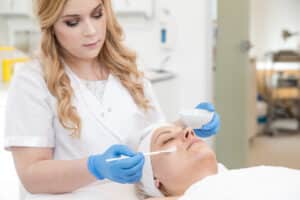What Is a Chemical Peel?
A chemical peel is a cosmetic procedure that uses various chemical substances that react with the upper layers of the skin. These chemicals cause minor skin damage and trigger wound healing that leads to skin renewal. Chemical peels can help reduce signs of aging on the face, hands, chest, and neck, such as from sun damage, wrinkles, and fine lines. They can also be used to improve acne scars and remove skin growths such as seborrheic keratoses and actinic keratoses.
If you are considering a chemical peel, it is crucial to choose a medical professional who is knowledgeable about the skin and has extensive experience with chemical peels, such as a board-certified dermatologist or a dermatologic surgeon.
What Are the Types of Chemical Peels Commonly Available?
Chemical peels are often categorized by the depth of skin they affect, each with distinct uses and benefits:
- Superficial peels: Also known as called “lunchtime peels,” these are ideal for treating mild sun damage, actinic keratoses, skin color changes, melasma, and acne. Superficial peels do not typically improve the appearance of wrinkles or deep furrows. Mild acid such as alpha-hydroxy acid is typically used and penetrates only the outermost layer of skin. A series of weekly or monthly treatments may be needed to achieve the desired results.
- Medium peels: These are used to treat mild-to-moderate sun-damaged skin, fine winkles, skin color changes, actinic keratoses, melasma, and seborrheic keratoses. Trichloroacetic acid or glycolic acid are commonly used medium-depth chemical peeling agents.
- Deep peels: These are used for individuals with moderate-to-severe sun-damaged skin, deep wrinkles and furrows, skin color changes, and acne scars. Phenol is a common chemical used for deep peels.
What Do I Need to Do to Prepare for a Chemical Peel?
Preparation for a chemical peel varies based on the type of peel you will undergo. Prior to any chemical peel, your medical professional may recommend:
- Taking an antiviral medication if you have a history of herpes simplex virus (HSV) skin infection of the face (ie, cold sores).
- Using a retinoid cream and/or bleaching agent.
- Avoiding other cosmetic treatments such as home microdermabrasion, depilatories, and waxing for at least 1 week before the procedure to help maximize healing.
For deep chemical peels, your medical professional may want you to have certain laboratory work, such as a blood count and electrocardiogram.
What Can I Expect During a Chemical Peel?
The procedure varies depending on the depth of the peel:
- Your medical professional will thoroughly cleanse your skin.
- They will apply the chemical solution (glycolic acid, salicylic acid, etc.) to the appropriate areas of your skin, typically using a brush, gauze, sponge, cotton ball, or cotton-tipped applicator.
- If there is stinging, a cool compress may be provided to apply.
- After a few minutes, the chemical is washed off or neutralized with a neutralizing solution.
For deep peels, the procedure should be performed in a surgical setting with general anesthesia.
What Can I Expect Following a Chemical Peel?
Healing varies widely depending on the type of peel:
- Superficial peels: The skin may be pink to red for a few hours to days with no downtime.
- Medium peels: It is normal for the skin to have mild oozing of clear fluid, mild redness, and gradual peeling during the next 7-14 days.
- Deep peels: A bandage is typically left in place and heeling takes 14-21 days. Deep peels will require closer follow-up during the first 3 months to assess improvement and side effects.
The treated skin will eventually peel off, revealing smoother, more youthful skin underneath.
What Follow-up Care Should I Take after a Chemical Peel?
Your medical professional will provide instructions for following up as well as signs to look for that are cause for concern, such as infection, flare-ups of certain medical conditions, scarring, and skin color changes.
Following the chemical peel, follow all instructions from your medical professional. Generally, you should:
- Apply an ice pack to the affected area to reduce the swelling and discomfort.
- Avoid picking, rubbing, or scrubbing the skin, as the skin needs to naturally become dry and peel on its own.
- Use a moisturizer to reduce irritation.
- Avoid sun exposure and tanning beds.
- Wear a broad-spectrum sunscreen (that protects against both UVA and UVB rays) of SPF 30 or higher every day.
What Are the Risks and Potential Side Effects Associated with Chemical Peels?
Side effects associated with chemical peels include:
- Skin color changes, such as redness, similar to a sunburn.
- Temporary darkening or lightening of the skin.
- Scarring.
- Cardiac concerns, particularly with deep peels.
What Else Should I Know about Chemical Peels?
Follow up with your medical professional for any additional treatments or if you notice signs of infection (such as pain, spreading redness, or fever). Adhering to the post-procedure care instructions is vital to achieve the best results and minimize risks.
Last modified on February 6th, 2025 at 1:17 pm
